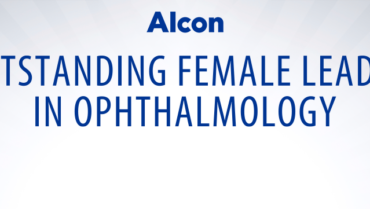
Dr. Epitropoulos is a Founding Member of The Eye Center of Columbus and a Clinical Assistant Professor at The Ohio State University Wexner Medical Center.
1. Please share with us your background.
I am a native of Columbus, Ohio, and received a bachelor’s degree in nursing from The Ohio State University (OSU). After working as a registered nurse in a surgical intensive care unit, I attended OSU’s nurse anesthesia program, at which time I decided to pursue a degree in medicine. Because of my experiences in nursing, I was able to earn my medical degree in 3 years through OSU’s independent study program. (I also had my first child during my second year of medical school.)
I completed my internship at Riverside Methodist Hospital, and I returned to OSU for my residency in ophthalmology, where I served as Chief Resident. After training, I became a founding member of The Eye Center of Columbus, an innovative institution of more than 80 ophthalmologists, located in downtown Columbus. In addition to my private practice at Ophthalmic Surgeons & Consultants of Ohio, I serve as a Clinical Assistant Professor of Ophthalmology at OSU’s Wexner Medical Center. I can’t seem to stay away from the Buckeyes!
Outside of practicing medicine, I have enjoyed developing, patenting, and ultimately licensing a validated glare tester (EpiGlare Tester) to measure the disabling effect of glare and sunlight in patients with cataracts. I was awarded the Outstanding Woman in Technology award in 2008 from Tech Columbus for this innovation. The EpiGlare Tester was launched at the 2015 AAO annual meeting. The IP was licensed to Eye Care & Cure, and the technology is now being used in offices to evaluate glare disability in cataract patients.
I serve on the Ocular Surgery News editorial board and am a member of the ASCRS Instrumentation and IOL Subcommittee. I am also one of the cofounders of CEDARS/ASPENS, a not-for-profit society of anterior segment surgeon educators whose mission is to expand the knowledge of ophthalmic surgery and foster excellence in patient care through clinical experience, peer-to-peer exchange, and practice education. I enjoy speaking and teaching nationally and internationally on cataract and refractive surgery and innovations in ocular surface disease and participating in clinical research and clinical trials to evaluate new technologies.
I have been one of the team physicians for the Columbus Blue Jackets since their founding and was a member of the NBC-4 Health Team for 12 years. My father, a retired endocrinologist, has served as an influential role model throughout my career. My husband has been a great support system for me, and we have two children—our daughter, a dentist, is married with a 2-year-old son, and our son is attending his first year of medical school in Knoxville, Tennessee.
2. What is the focus of your current research?
I am actively involved in clinical research and clinical trials to evaluate new technologies in cataract surgery, premium IOLs, and ocular surface disease. I enjoy teaching through research, lectures, and surgical wet labs.
3. What has your experience been collaborating with industry?
I enjoy collaborating with industry and truly feel that this partnership contributes to my goal of optimizing patient outcomes. I have become more involved in clinical trials sponsored by industry, and I find it rewarding to be able to influence innovation to ultimately improve patient care.
4. In your opinion, how is the role of women in ophthalmology evolving?
Women have made great strides in ophthalmology and have gained more opportunities to speak from the podium, serve as key opinion leaders, and become involved in clinical research. We are also seeing more women assume leadership positions within national organizations. The outlook for the future of women in ophthalmology is even more encouraging because both medical schools and ophthalmology residency programs now have higher numbers of women than men. The notable accomplishments of several female ophthalmologists (such as Marguerite McDonald, MD, who performed the first excimer laser treatment in 1987) have, in turn, created opportunities and served as inspiration for other women in the field.
5. What, if any, hurdles do you feel women in health care still face?
We should be proud of how far women have come in medicine. Women are now commonly taking leadership roles within private practices, in academic institutions, and on advisory boards as well as moderating panels and speaking from the podium. In addition, there are now more female residents and medical students than ever. However, we need to be realistic about how far there is still to go. Despite the growing numbers of women in ophthalmology, we don’t see the same percentage of women in academic positions or on the podium delivering keynote addresses and named lectureships.
Women in medicine face unique challenges in harmonizing their home life with their work life. With issues concerning maternity leave, sick children, and other family responsibilities, professional women are sometimes unable to fully commit themselves to their work. Raising a family, however, shouldn’t preclude anyone from being a successful clinician or surgeon, as there can be a balance between both endeavors, especially with a good support system, time management, and organization skills in place.
6. What advice can you offer to young female ophthalmologists who are still in training or just beginning their careers?
Ophthalmology is an extremely rewarding profession, and it is important to always keep in mind that the primary goal is to take superior care of patients. I would advise young ophthalmologists to find something that they truly like, to strive to excel at it, but to never stop learning—it’s a lifelong process.
If you are interested in becoming a leader in the field, take initiative and be proactive. Conduct clinical research, innovate, network, and follow your passion. Join organizations that provide an environment for women to collaborate, present at the podium, and network worldwide, such as Ophthalmic World Leaders (OWL), Women in Ophthalmology (WIO), MillennialEYE, and ASCRS. These organizations acknowledge and educate members on the tools they need for success and help open the door to new opportunities. Participating in mentorship programs through organizations such as CEDARS/ASPENS or MillennialEYE provides an opportunity for future leaders in ophthalmology to gain the confidence and support needed to achieve their goals. Mentors, however, are needed at all levels in life. It is important both to have good mentors and to be a good mentor throughout your career and professional journey.
7. Can you propose a unique or creative idea that may help women in ophthalmic practices?
Women in medicine should create an online chat forum to discuss the opportunities and obstacles they face. Through such a platform, female physicians could share their experiences and provide or seek out advice. This would help provide women with a formal support system and a venue to collaborate.
PUBLISHED WORKS
1. Epitropoulos AT, Matossian C, Berdy GJ, et al. Effect of tear osmolarity on repeatability of keratometry for cataract surgery planning. J Cataract Refract Surg. 2015;41:1672-1677.
2. Epitropoulos AT, Donnenfeld ED, Shah ZA, et al. Effect of oral re-esterified omega-3 nutritional supplementation on dry eyes. Cornea. 2016;35:1185-1191.
3. Fogt JS, Kowalski MJ, King-Smith PE, et al. Tear lipid layer thickness with eye drops in meibomian gland dysfunction. Clin Ophthalmol. 2016;2016:2237-2243.
4. Epitropoulos AT, Goslin K, Bedi R, Blackie CA. Meibomian gland dysfunction patients with novel Sjögren’s syndrome biomarkers benefit significantly from a single vectored thermal pulsation procedure: a retrospective analysis. Clin Ophthalmol. 2017;11:701-706.
5. Epitropoulos AT. Clinical study: visual and refractive outcomes of a toric presbyopia-correcting intraocular lens. J Ophthalmol. 2016;2016:7458210.
6. Epitropoulos AT, Fram N, Masket S, et al. Evaluation of a new controlled point source LED glare tester for disability glare detection in participants with and without cataracts. J Refract Surg. 2015;31(3):196-201.
7. Epitropoulos AT. Evaluation of single thermal pulsation treatment for meibomian gland dysfunction and dry eye. Paper presented at: the ASCRS annual meeting; April 2015; San Diego, CA.
8. DiSilvestro RA, Thomas S, Harrison E, Epitropoulos A. A pilot comparison of phospholipidated lutein to conventional lutein for effects of plasma lutein concentrations in adult people. Nutr J. 2015;14:104.
9. Epitropoulos AT. Axial length measurement acquisition rates of two optical biometers in cataractous eyes. Clin Ophthalmol. 2014;2014(8):1369-1376.
10. Weber PA, Burton GD, Epitropoulos AT. Laser trabeculoplasty retreatment. Ophthalmic Surg. 1989;20(10):702-706.
11. Epitropoulos AT, Donaldson KE, Matossian C, McDonald M. Female? 40ish? Look for OSD. Ophthalmology Management. March 2016.
12. Matossian C, Epitropoulos AT, Rowen S, Beckman KA. Different approaches available to determine the axis of astigmatism for toric implants. Ocular Surgery News. October 2017.
13. Epitropoulos A. Refractive surgery for patients with severe dry eye. Cataract & Refractive Surgery Today. March 2015.
14. Epitropoulos AT. Dry eye disease: creating more awareness. Cataract & Refractive Surgery Today. June 2015.
PROFESSIONAL SOCIETY MEMBERSHIPS
- American Academy of Ophthalmology
- American-European Congress of Ophthalmic Surgery
- American Medical Association
- American Society of Cataract and Refractive Surgery
- Association for Research in Vision and Ophthalmology
- CEDARS/ASPENS
- Columbus Medical Association
- Fellow American College of Surgeons
- International Society of Refractive Surgery
- Ohio Ophthalmological Society
- Ohio State Medical Association
- Ophthalmic World Leaders
- Women in Ophthalmology
HONORS AND AWARDS
- Top Refractive Surgeon, Docs Rate the Docs, WBNS-10TV Honor | 2003 to 2019
- Best Doctors | 2010 to 2019
- Top Doctor Award | 2016 to 2019
- OSN Premier Surgeon 300 Innovators in Refractive Cataract Surgery | 2018
- Outstanding Woman in Technology by Tech Columbus, Innovations Awards | 2008
- Chief Resident: The Ohio State University College of Medicine, Ophthalmology Department | 1992 to 1993
- Eli G. Alcorn Prize in Ophthalmology, The Ohio State University
- Department of Surgery Award, The Ohio State University
- Department or Radiology Award, The Ohio State University
- Department of Physiology Award, The Ohio State University
- William F. Ashe Award, Department of Preventive Medicine Award, The Ohio State University
- Basic Sciences (Med I) Honor, The Ohio State University
- Honor, Department of Anatomy, The Ohio State University
- Honor, Department of Surgery, The Ohio State University


